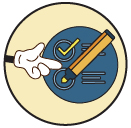This is part of the ADA Title 2 toolkit, a resource to help public entities start building digital accessibility strategies.
Video content are any videos you share on your website, social media, or LMS. If you link to or embed the video, it is your responsibility to make sure it’s accessible.
These are tasks and examples to start building your video content accessibility strategy. It is broken into three parts:
- Identify environment
- Put processes in place
- Fix existing content
 Identify environment
Identify environment
Goal: Discover content you have, the current state, and any opportunities you can build on.
Tasks
A task or process Pope Tech does for you or supports is marked with **.
- Inventory videos**
- Find who creates videos. This could be individuals or departments.
- Identify any content policies concerning video content that already exist.
- Learn about the current process for creating video content.
- Find potential opportunities to build on.
Potential opportunities
Here are examples of opportunities you might find:
- A central team whose main responsibility is to produces video content.
- Tools that easily identify videos missing captions.
- Departments or teams that are willing or excited about the work.
- Processes or people that are already doing things well.
- People are eager to add captions to videos because they have benefits.
 Put processes in place
Put processes in place
Goal: Build a digital accessibility strategy that maintains your content’s accessibility.
Tasks
A task or process Pope Tech does for you or supports is marked with **.
- Leadership buy-in
- Meet with leadership to inform them of the current state, needs, goals, and get support for policies or resources (if needed).
- Follow up with leadership regularly.
- New process for maintaining accessibility
- Define and publish new organizational policies (if needed).
- Define the new process (that includes accessibility checks) for creating accessible videos.
- Create a plan to communicate the new process/policy and track adoption. This could include email campaigns, training, videos, incentives, and more.
- Create a training plan for those who work with videos. Topics should include captions, contrast, audio descriptions, and flash thresholds.
- Training and communication
- Make a list of people you’ll communicate with about policies, processes, training, etc. (This could include people you have already identified, stakeholders, and other supporting groups).
- Carry out the communication plan.
- Host any necessary trainings or check in with people to make sure they’ve completed training.**
- Track adoption.
- Document expectations, processes, and training requirements for new hires and share with departments or teams.
- Start regular video testing
- Create a process for when there are inaccessible videos going forward. How will they be handled?
- Set up automatic accessibility testing for video content to keep track of new video content.**
Potential opportunities
- Central teams that can support captioning and audio description needs.
- Tools that make captioning easier.
- Creating a policy that dictates the standard and what happens if it isn’t met can keep everyone accountable.
- Sharing wins and progress publicly could motivate different teams to be a part of the effort.
- Start small with groups who want to be part of it. Share their wins and make changes for a larger rollout.
Example of implementing video captions process
This is how a large higher-ed institution implemented a captions strategy and got all new videos to include captions.
- They decided to focus on captions because there were tools that supported it, and it was easy to get people on board.
- Used Pope Tech to test all videos for human caption tracks.
- Worked with leadership to establish a policy that said all videos starting on a certain date had to have captions or they would be taken down.
- Partnered with a 3rd party vendor to caption videos.
- Created an easy flow for departments to request captioning. They would complete an online form.
- Communicated new flow and requirement to all departments.
- Trained central team on accessible videos and how to complete caption requests.
- Created training materials departments could use to caption their own videos if they didn’t want to pay for vendor to do it.
- Currently run regular automated testing on all videos for human caption track. Accessibility team follows up with departments that have videos with no human caption track and provides the policy and resources.
 Fix existing issues
Fix existing issues
Goal: Test existing content and fix accessibility issues.
Tasks
A task or process Pope Tech does for you or supports is marked with **.
- Determine in-scope existing content.**
- Test in-scope content and find opportunities.**
- Determine who is responsible for testing and updating existing video content.
- Document work in the central project management system that also has non-accessibility-related tasks (if relevant). Or, create a project tracker.**
- Set goals, starting with easy wins and opportunities.
- Create a plan for escalating potential blocks and barriers.
- Schedule regular check-ins with all applicable stakeholders and contributors.
Potential opportunities
- Videos or channels with high views.
- Focusing on captions first and other changes that require editing the video second.
Want a jump start?
Our accompanying webinar covers how to break up your accessibility efforts into more manageable pieces with real-life examples.
Start in the right direction quicker.
Our experts are here to help plan your ADA compliance strategy.
 How Pope Tech helps
How Pope Tech helps
Fixing existing issues and building an accessibility strategy that people actually adopt is difficult. It requires inventorying, training, continuous communication, planning, and tracking.
Pope Tech’s platform aims to simplify accessibility by supporting multiple parts of your accessibility strategy.

Identify your content
- Inventorying webpages
- Inventorying videos
- Inventorying PDFS
- Inventorying all Canvas course content

Prevent future issues
- Accessibility topic training for contributors
- Product training for organization
- Accessibility documentation to help people learn as they go
- Scheduled automated and manual testing
- Scheduled and automated reporting to anyone in your organization
- Easy-to-use dashboard to track progress and spot emerging issues
- User organization to make sure everyone has access to what they need

Test and fix existing issues
- Automated accessibility testing
- Guided manual testing flow
- Integrations with Jira, Asana, and email to send tasks directly to contributors
- API integrations to customize your flows
- Identifying issues with 3rd party tools
- Access to accessibility experts to answer any questions






